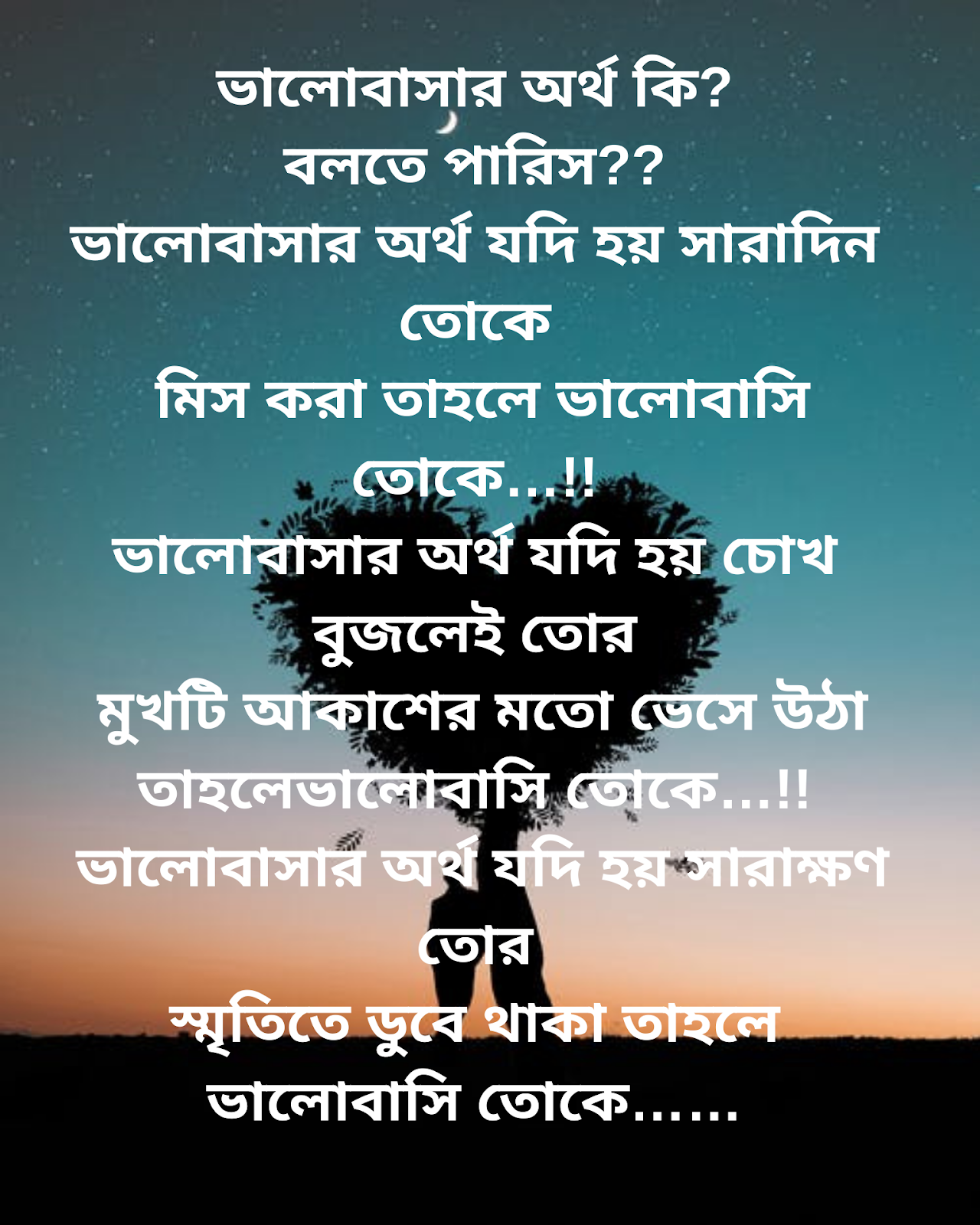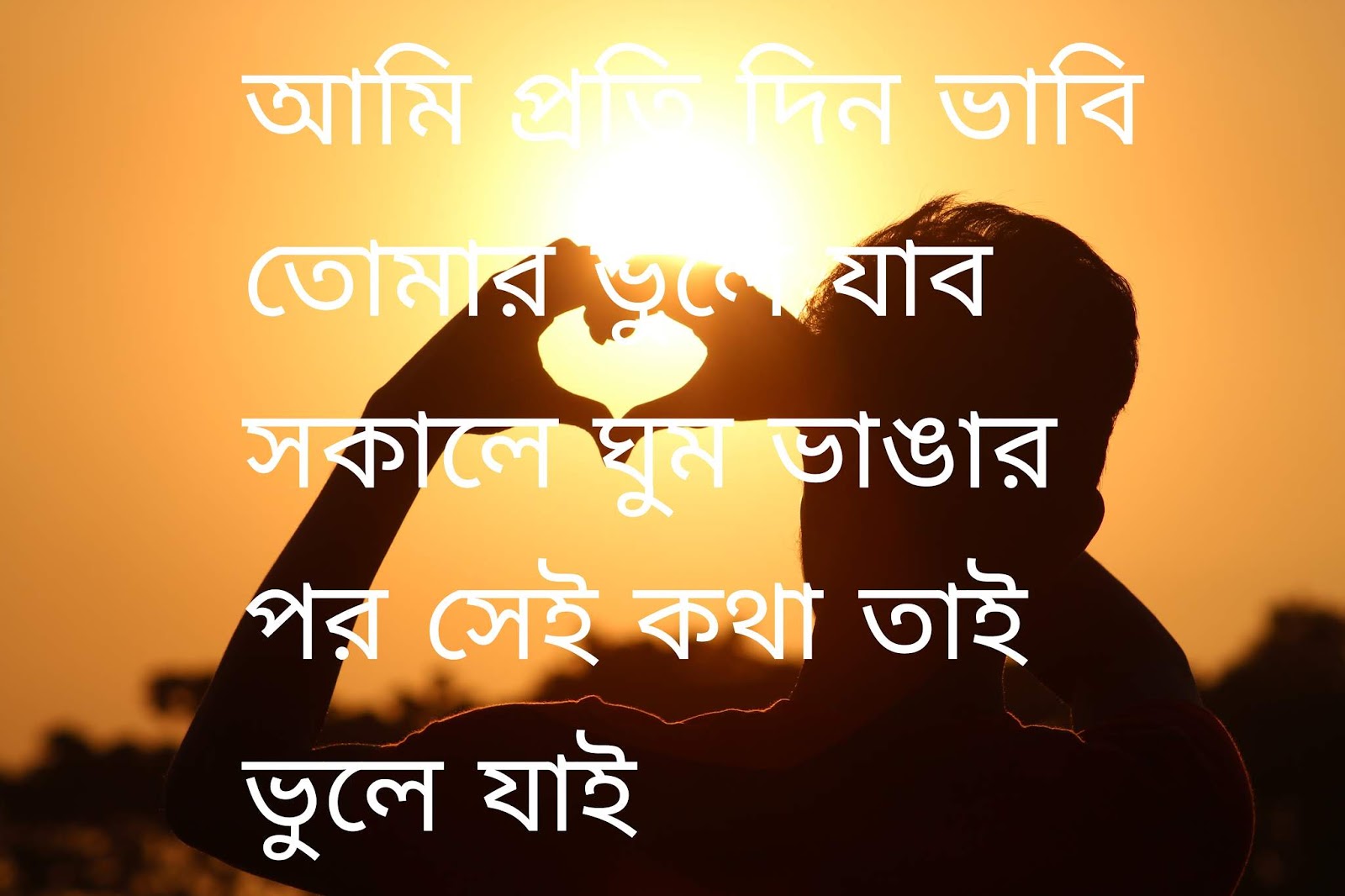What is the meaning of shayari in Bengali? Shayari is a form of Urdu poetry that is often characterized by its use of metaphor, simile, and other figures of speech. It is often used to express love, longing, or other strong emotions. Shayari is popular in both India and Pakistan, and there are many famous shayari poets, such as Mirza Ghalib and Faiz Ahmed Faiz.
Shayari is often written in a very condensed and allusive style, which can make it difficult to understand for non-native speakers. However, there are many resources available online and in libraries that can help you to learn more about shayari and its meaning.
Shayari is a beautiful and expressive form of poetry that can be enjoyed by people of all cultures. If you are interested in learning more about shayari, there are many resources available to help you get started.
Here are some of the benefits of reading shayari:
- Shayari can help you to learn more about Urdu culture and language.
- Shayari can help you to express your emotions in a creative and beautiful way.
- Shayari can help you to relax and de-stress.
If you are interested in reading shayari, there are many resources available online and in libraries. You can also find shayari groups and workshops in many cities.
shayari meaning in bengali
Shayari, a form of Urdu poetry, holds cultural and emotional significance, often expressing love, longing, and other strong emotions through metaphor and simile. Here are seven key aspects that explore various dimensions of shayari meaning in Bengali:
- Origin: Rooted in Persian and Arabic influences, shayari emerged as a distinct literary form in the Indian subcontinent.
- Language: While primarily composed in Urdu, shayari has significantly influenced Bengali literature and culture.
- Themes: Love, separation, longing, and the complexities of human relationships are common themes explored in shayari.
- Style: Characterized by brevity, alliteration, and rhythmic patterns, shayari conveys emotions with depth and impact.
- Cultural Significance: Shayari is deeply ingrained in South Asian culture, recited at gatherings, festivals, and special occasions.
- Literary Influence: Prominent Bengali poets like Rabindranath Tagore and Kazi Nazrul Islam incorporated elements of shayari into their works.
- Contemporary Relevance: Shayari continues to inspire modern-day poets, musicians, and artists, bridging traditional and contemporary expressions.
These aspects highlight the multifaceted nature of shayari meaning in Bengali. From its historical origins to its enduring cultural significance, shayari serves as a bridge between languages, emotions, and generations.
Origin
The origins of shayari in Persian and Arabic influences significantly shaped its meaning in Bengali. Persian and Arabic languages brought a rich vocabulary, poetic forms, and literary traditions that influenced the development of shayari in the Indian subcontinent. This fusion resulted in a unique literary expression that
The influence of Persian and Arabic poetry can be seen in the use of metaphors, similes, and other figures of speech in shayari. These literary devices allow poets to express complex emotions and ideas in a concise and evocative manner. Additionally, the adoption of poetic forms such as the ghazal and nazm provided a structure for shayari that facilitated the exploration of various themes and emotions.
Understanding the Persian and Arabic origins of shayari is crucial for appreciating its meaning in Bengali. This knowledge provides a deeper insight into the cultural and linguistic roots of shayari, enabling a more nuanced interpretation of its themes and expressions.
Language
The connection between the language of shayari and its meaning in Bengali is multifaceted and profound. Here are three key facets that explore this relationship:
- Literary Exchange: Shayari, primarily composed in Urdu, entered the Bengali literary scene through translations and adaptations. This exchange exposed Bengali writers and audiences to the nuances and expressive potential of shayari, leading to its assimilation into Bengali literature.
- Cultural Interplay: The geographical proximity and cultural interactions between Bengal and Urdu-speaking regions fostered the exchange of ideas and artistic influences. Shayari, as a prominent genre in Urdu literature, found resonance in Bengali culture, influencing the development of Bengali poetry and literary styles.
- Shared Poetic Sensibilities: Despite linguistic differences, Bengali and Urdu share certain poetic sensibilities and aesthetic principles. The emphasis on emotions, the use of metaphor and imagery, and the exploration of universal human experiences created a common ground for shayari to flourish in Bengali.
These facets highlight the dynamic relationship between language and meaning in the context of shayari in Bengali. The influence of Urdu on Bengali literature facilitated the adoption and adaptation of shayari, enriching the Bengali literary landscape and deepening its emotional and aesthetic expressions.
Themes
The exploration of love, separation, longing, and the complexities of human relationships is central to the meaning of shayari in Bengali. These universal themes resonate deeply with the human experience, transcending cultural and linguistic boundaries.
Shayari provides a unique lens through which poets express the myriad emotions and experiences associated with love and relationships. Love, in its various forms, is a recurring subject in shayari, celebrated in its moments of ecstasy and lamented in its absence. Separation, with its accompanying pain and longing, is another prominent theme, evoking a sense of profound loss and yearning.
Beyond romantic love, shayari also explores the complexities of human relationships, delving into themes of friendship, family, and societal dynamics. The examination of these relationships reveals the nuances of human nature, highlighting both its capacity for love and compassion, as well as its potential for conflict and misunderstanding.
Understanding the significance of these themes is crucial for appreciating the depth and richness of shayari meaning in Bengali. These themes provide a framework for interpreting the emotions and experiences expressed in shayari, allowing readers to connect with the universal human condition.
Style
The distinctive style of shayari, characterized by brevity, alliteration, and rhythmic patterns, plays a pivotal role in conveying emotions with depth and impact in Bengali literature.
- Brevity: Shayari's concise form allows poets to capture the essence of an emotion or experience in a few carefully chosen words. This brevity intensifies the impact of the message, leaving a lasting impression on the reader's mind.
- Alliteration: The use of alliteration, the repetition of consonant sounds, creates a musicality in shayari that enhances its emotional appeal. Alliteration draws attention to specific words and phrases, emphasizing their significance and creating a memorable impact.
- Rhythmic Patterns: Shayari adheres to specific rhythmic patterns, such as the "matla" and "maqta," which contribute to its melodic flow. These rhythmic patterns not only add to the aesthetic appeal of shayari but also aid in memorization and recitation, ensuring its widespread popularity.
The unique combination of brevity, alliteration, and rhythmic patterns in shayari enables poets to convey a wide range of emotions with precision and power. These stylistic elements elevate shayari beyond mere words, transforming it into a potent form of emotional expression that resonates deeply with readers.
Cultural Significance
The cultural significance of shayari in South Asian culture is deeply intertwined with its meaning in Bengali. Here are three key facets that explore this connection:
- Social Bonding: Shayari plays a vital role in fostering social bonding within South Asian communities. Recited at gatherings, festivals, and special occasions, shayari provides a shared platform for expressing emotions, connecting with others, and celebrating cultural heritage.
- Emotional Expression: Shayari offers a nuanced and evocative language for expressing a wide range of emotions, from love and joy to sadness and longing. Its use in various social contexts allows individuals to communicate their innermost feelings in a culturally resonant and meaningful way.
- Cultural Identity: Shayari is an integral part of South Asian cultural identity. Through its themes, imagery, and use of language, shayari reflects the values, beliefs, and aspirations of the region, contributing to a sense of shared heritage and collective consciousness.
These facets highlight the profound connection between the cultural significance of shayari and its meaning in Bengali. Shayari is not merely a form of poetry but a vibrant expression of South Asian culture, deeply embedded in the social, emotional, and identity-shaping aspects of life.
Literary Influence
The incorporation of shayari elements by prominent Bengali poets like Rabindranath Tagore and Kazi Nazrul Islam significantly enriched the meaning and expression of Bengali literature.
- Thematic Exploration: Shayari's themes of love, longing, and separation resonated deeply with these poets, who explored them in their works, expanding the emotional range of Bengali poetry.
- Stylistic Influence: Tagore and Nazrul Islam incorporated shayari's brevity, alliteration, and rhythmic patterns into their poetry, enhancing its musicality and emotional impact.
- Cultural Bridge: By incorporating shayari elements, these poets bridged the cultural gap between Urdu and Bengali literature, fostering a sense of unity and shared heritage.
- Modernization of Bengali Poetry: The influence of shayari contributed to the modernization of Bengali poetry, moving it away from traditional forms and towards a more contemporary and expressive style.
The literary influence of shayari on Rabindranath Tagore and Kazi Nazrul Islam showcases its profound impact on the meaning of Bengali poetry. It broadened the thematic scope, enriched the stylistic landscape, and played a pivotal role in shaping the modern Bengali literary landscape.
Contemporary Relevance
The enduring relevance of shayari in contemporary times is a testament to its profound meaning in Bengali. Modern-day poets, musicians, and artists continue to draw inspiration from shayari, infusing their works with its timeless themes and expressive style.
This contemporary relevance manifests in various forms. Poets like Javed Akhtar and Gulzar incorporate shayari's lyrical quality and emotional depth into their poetry, resonating with audiences across generations. Musicians blend shayari with modern musical genres, creating fusion compositions that bridge traditional and contemporary soundscapes. Artists employ shayari's imagery and metaphors in their visual creations, evoking emotions and storytelling through different mediums.
The significance of shayari's contemporary relevance lies in its ability to transcend time and connect with modern sensibilities. It demonstrates the enduring power of shayari's themes, its adaptability to evolving artistic expressions, and its capacity to inspire creativity across disciplines. Understanding this contemporary relevance deepens our appreciation of shayari meaning in Bengali, showcasing its enduring impact on the cultural and artistic landscape.
FAQs on "shayari meaning in bengali"
This section addresses frequently asked questions to provide a comprehensive understanding of shayari's meaning in Bengali.
Question 1: What is the essence of shayari in Bengali?
Shayari in Bengali encapsulates a realm of emotions, exploring themes of love, longing, and the intricacies of human relationships. Its essence lies in conveying these emotions with depth and impact, often through the use of metaphors, similes, and rhythmic patterns.
Question 2: How does shayari differ from other forms of poetry?
Shayari distinguishes itself through its brevity and lyrical quality. It often adheres to specific rhythmic patterns and rhyme schemes, allowing for a musical and memorable recitation. Additionally, shayari's use of figurative language and evocative imagery creates a rich tapestry of emotions and experiences.
Question 3: What are some prominent themes explored in shayari?
Shayari delves into a wide range of themes, including love, separation, longing, the complexities of relationships, and the human condition. It provides a platform for poets to express their innermost feelings and emotions, often with a touch of melancholy and introspection.
Question 4: How has shayari influenced Bengali literature and culture?
Shayari has profoundly influenced Bengali literature, enriching its thematic scope and expressive capabilities. Prominent poets like Rabindranath Tagore and Kazi Nazrul Islam incorporated elements of shayari into their works, contributing to the modernization and emotional depth of Bengali poetry.
Question 5: Is shayari still relevant in contemporary times?
Shayari continues to resonate with modern sensibilities, inspiring contemporary poets, musicians, and artists. Its timeless themes and evocative style lend themselves to diverse artistic expressions, from poetry and music to visual arts and storytelling.
Question 6: What makes shayari meaningful in the context of Bengali culture?
Shayari's significance in Bengali culture stems from its ability to express universal emotions in a nuanced and culturally resonant manner. It provides a shared language for Bengalis to explore their inner worlds, connect with their heritage, and appreciate the beauty and complexity of human experiences.
We hope these FAQs have shed light on various aspects of shayari meaning in Bengali. Understanding these nuances enhances our appreciation of this rich and expressive literary form.
Transitioning to the next article section.
Conclusion
This exploration of "shayari meaning in bengali" has illuminated the multifaceted nature of this literary form. Shayari's essence lies in its ability to capture and convey emotions with depth and impact, often through the use of figurative language and rhythmic patterns.
Shayari has significantly influenced Bengali literature and culture, enriching its thematic scope and expressive capabilities. Its timeless themes and evocative style continue to resonate with modern sensibilities, inspiring contemporary poets, musicians, and artists.
Understanding shayari's meaning in Bengali not only enhances our appreciation of this rich and expressive literary form but also provides a deeper insight into the cultural and emotional landscape of Bengal. By delving into the nuances of shayari, we gain a deeper understanding of the human condition and the universal experiences that connect us all.
You Might Also Like
Comprehensive Guide To Avner Netanyahu's Educational BackgroundMegan Fox: The Primetime Bombshell
HDHub4u: Watch Hindi Dubbed Movies Online
Jason Momoa Steals The Spotlight On Baywatch
Mesmerizing Love Story: Stream Your Favorite Romance On HdHub4u
Article Recommendations
- Angelaalvarez Onlyfans Leaked
- Jason Beghe
- Binghamton Skipthegames
- Hello Kitty Character Names
- Kimberly Guilfoyle
- Paul Walker Died
- Aishah Sofey Porn
- Jenna Ortega Sex Tape
- Alex Start X New 2024 Age
- Tina Trahan Age


